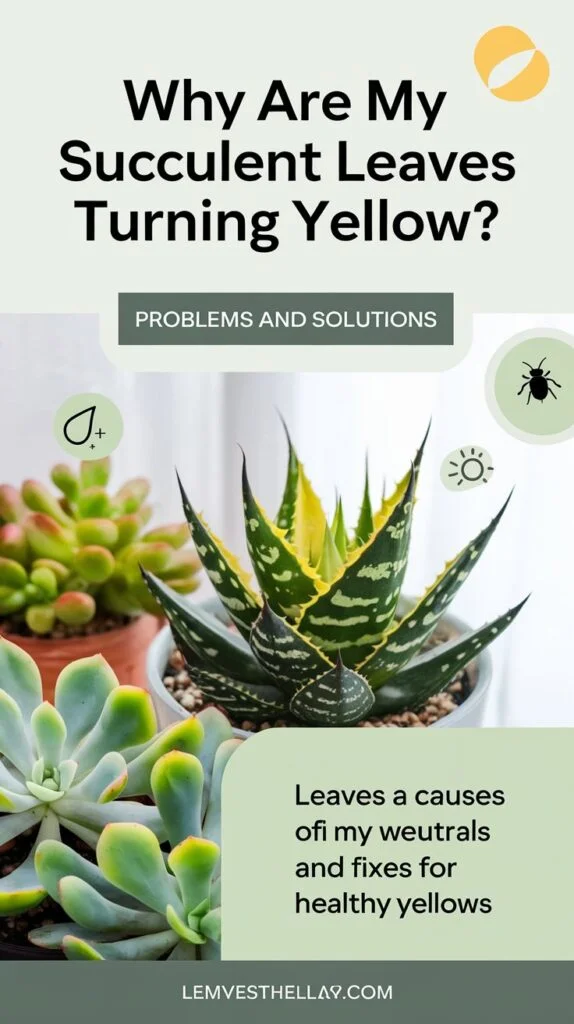Learn why your succulent leaves are turning yellow and discover expert solutions to revive your plants. Diagnose overwatering, pests, nutrient deficiencies, and more.
Noticing yellow leaves on your succulent ? These vibrant, resilient plants sometimes show signs of distress—learn how to fix it and keep them thriving.

Many plant enthusiasts wonder, ‘Why are my succulent leaves turning yellow?‘ This guide addresses… Succulents are unique plants that can withstand dry conditions because of their ability to store water in their leaves and stems. While some are cherished for their symmetrical growth and functions, like Echeveria and Aloe vera, others, like Candelabra spurge and the African Milk Tree, are sought after because of their architectural structure. Therefore, it can be very disheartening to see their leaves turning yellow prematurely. Don’t Worry! In this guide, we aim to cover all the common problems of yellowing and their solutions so that you can enjoy the company of your beloved houseplants for years to come.
Common Problems Behind Yellowing Succulent Leaves
1. Overwatering
Succulents thrive in dry conditions, but overwatering can cause waterlogging, leading to yellow leaves.
Solution: Allow the soil to dry completely and adjust the watering schedule according to your environment.
2. Deficiency of Nutrients
Although succulents can survive with little nutrients, they still need some to maintain the foliage. A nitrogen deficiency can thin succulent leaves, causing them to yellow over time.
Solution: Conduct a soil test to identify any deficiencies. Provide your succulents with a balanced and diluted fertilizer between spring and summer. Remember to dilute it to half its strength to avoid overfeeding.
3. Sunlight
Succulents need around 6 hours of direct sunlight to photosynthesize properly, and any lack thereof will cause leaves to turn yellow. Also, too much direct sunlight during the hotter part of the day can cause sunburn, which may appear as yellow patches on the leaves.
Solution: Move your succulents to brighter areas, such as south-facing windows, where they can get adequate sunlight. Introduce a sheer curtain during hotter periods if you notice sunburns.
4. Cold
Though some succulents can tolerate harsh winters, most of them struggle to survive in colder climates. While mild frost can cause leaves to turn yellow and mushy, extreme frost can kill your succulents overnight.
Solution: If your succulents are container-bound, relocate them to a warmer location away from cold drafts and windows. Provide a protective cover from the frost, if you are growing them outdoors.
5. Underwatering
If succulents don’t get enough water, they use the water stored in their stems to survive. Underwatering is another common problem that can lead to the shriveling and yellowing of our succulent leaves.
Solution: If the outermost layer of the soil feels dry, soak your succulents and let the water drain out completely from the drainage holes. To avoid yellowing because of underwatering, water them once every week during spring and summer.
6. Pests
This is a grower’s nightmare because pests like spider mites and mealy bugs munch on the plant’s sap, resulting in rapid yellowing among other diseases.
Solution: Observe your plant closely and use neem oil and insecticidal soap to control any infestation. Remove any infected part promptly to prevent it from spreading to other areas.
When to Seek Professional Help?
If you have tried all these solutions but your succulent’s health is not improving, it is probably time to seek out a horticulturist. They can curate specialized treatment plans after thoroughly assessing the condition.
Although yellowing leaves on our succulents can be worrisome, with proper diagnosis and care, we can restore their greenery in no time. Have tips or success stories about reviving yellowing succulents? Share them in the comments below—we’d love to learn from your experience!





